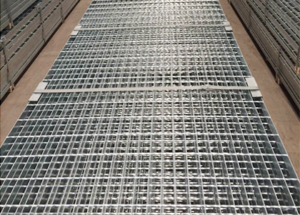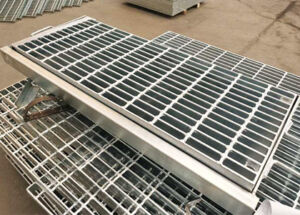Irin iserapọ irin jẹ ohun elo ara ẹni ati ti o tọ ti o n wa awọn ohun elo ni awọn aaye oriṣiriṣi. Ọkan ninu awọn aaye ohun elo akọkọ ti irin-ajo irin wa ni ilẹ-ilẹ ti ile-iṣẹ. Egan ati Anti-Stream Ipilẹti irin jẹ ki o jẹ apẹrẹ fun lilo ni awọn ile-iṣẹ, awọn ile-aye, ati awọn ohun elo ile-iṣẹ nibiti awọn ẹrọ ti o wuwo ati ijabọ ẹsẹ jẹ wọpọ. Apẹrẹ ṣiṣi ti irin-ajo irin ti a tun gba laaye fun fifa omi ti awọn olomi, ṣiṣe ti o dara fun awọn agbegbe prone si awọn ọkọ ayọkẹlẹ tabi ikojọpọ ọrinrin.
Aaye ohun elo miiran ti o ṣe pataki ti irin-ajo irin wa ni ikole ti awọn rin rinwa ati awọn iru ẹrọ. Irin isegun irin pese aaye kan ti o ni aabo ati iduroṣinṣin fun alarinkiri ati ijabọ irin ni awọn agbegbe gbangba, afara, ati awọn ọna ita gbangba. Iwọn-agbara giga-si-iwuwo jẹ ki o yan yiyan fun awọn ayaworan ati awọn ẹrọ ara nwa lati ṣe apẹrẹ ailewu ati awọn ẹrọ gigun-gigun gigun. Ni afikun, irin ti o mọ le jẹ adani lati pade awọn ibeere fifuye pato, Siwaju sii gbooro si ohun elo rẹ ni ile-iṣẹ ikole.

Awọn eka irinna tun awọn anfani lati ohun elo ti wiwa irin. O ti lo wọpọ ni infuri ti awọn ideri trench, Awọn iru oju opopona, ati awọn ọna opopona nitori iduroṣinṣin rẹ si awọn ẹru nla ati awọn ipo agbegbe ti agbegbe. Irin awọn nfunni ni ipese ti ọrọ-aje ati kekere-isalẹ fun idaniloju idaniloju aabo ati iṣẹ-iṣẹ ti awọn amayederun ọkọ. Agbara rẹ ati awọn ohun-ini egboogi ṣe o jẹ ki o yan yiyan fun gbigbe daradara ati yiya pẹlu irin-ajo ati ijabọ afẹsẹgba.
Ninu ayaworan ati ipo apẹrẹ inu inu, irin-ajo ti wa ni lilo fun awọn idi ọṣọ daradara bi awọn eroja iṣẹ ṣiṣe. Awọn oniwe-igbalode ati darapupo ti iṣelọpọ jẹ ki o yan ti o gbajumọ fun didi, Oorun, ati awọn ohun elo iboju ni iṣowo ati ibugbe ibugbe. Irin-ajosi irin tun le ṣepọ si awọn aye inu inu bi awọn ipin, Irin grating jẹ besikale ni ti Bearing bar ati Cross bar nipa laifọwọyi tẹ alurinmorin ẹrọ bi wọnyi chart, ati awọn aranpo oju omi, Ṣafikun ifọwọkan ati ifọwọkan minter kan si apẹrẹ gbogbogbo. Vomatilẹyin ti irin isegun irin gba awọn ayaworan ati awọn apẹẹrẹ lati ṣawari awọn ọna imotuntun ti sisọnu rẹ sinu ọpọlọpọ igbekale ati awọn eroja ọṣọ.
Awọn agbara ati eka ti o le dapo si irin-ajo irin fun ọpọlọpọ awọn ohun elo. O ti lo wọpọ ni awọn irugbin agbara, refineries, ati awọn ohun elo kemikali fun resistance ina rẹ, Awọn ohun-ini Itulọ, ati wiwọle fun itọju. Irin. Iseda ti kii ṣe adaṣe tun jẹ ki o dara fun lilo ninu awọn idapo itanna ati awọn agbegbe folti giga, Siwaju sii ṣafihan ohun elo oriṣiriṣi rẹ ni ile-iṣẹ agbara.
Awọn ohun elo mimu ti irin ti o gbooro si awọn ẹka si-ogbin ati ounjẹ daradara. O nlo ni awọn aye ti o livessock, Awọn irugbin sisẹ ounje, ati awọn ẹrọ ogbin nitori hyginic ati ohun ti o mọ-si-mọ. Irin iṣiro kikun ti o ṣii gba fun fifa omi daradara ti awọn ohun elo ati awọn fifa omi, igbelaruge agbegbe mimọ ati imọ-jinlẹ. Agbara rẹ ati resistance si corrosioni jẹ ki o jẹ ohun elo bojumu fun idiwọ awọn italaya ti awọn iṣẹ ṣiṣe ti ogbin ati ounjẹ.

Awọn anfani ile-iṣẹ ati kuro ni awọn anfani ile-iṣẹ lati awọn ohun-ini ohun-elo. O ti lo wọpọ ni awọn deki ọkọ oju omi, Awọn iru ẹrọ, ati awọn ohun elo oju papo nibiti ifihan si awọn oju ojo ti o nira ati awọn ipo oju ojo sursh jẹ gbilẹ. Irin ti nrapọ pese ile-iṣẹ ti ko ni aabo ati awọn oṣiṣẹ, idasi si ailewu ati iṣẹ ti o ni gbogbogbo ati awọn ẹya pashore. Agbara rẹ lati ṣe idiwọ awọn ipo ayika iwọn jẹ ki o yan yiyan fun awọn ohun elo Marine.
Ni paripari, awọn aaye ohun elo ti irin-ajo irin jẹ Oniruuru ati giga, Warrang kọja awọn ọja bii ikole, gbigbe, ayaworan, agbara, ẹkọ ọgbin, ati marine. Ijọpọ rẹ, agbara, ati okun ṣe ohun elo ti o ṣe akiyesi fun iwọn ti o ni igbekale, iṣẹ ṣiṣe, ati awọn idi ore-inu.

